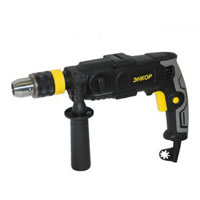 If we consider the question of the difference between a puncher and a drill, then these are essentially completely different tools, although they can replace each other in most cases. The concept of a drill-hammer does not exist in nature, however, according to the Enkor company, they offered for sale just such a tool - the ENKOR PE-420/12ER Hammer Drill. As they say, the power of a hammer drill is combined with the lightness of an electric drill.
If we consider the question of the difference between a puncher and a drill, then these are essentially completely different tools, although they can replace each other in most cases. The concept of a drill-hammer does not exist in nature, however, according to the Enkor company, they offered for sale just such a tool - the ENKOR PE-420/12ER Hammer Drill. As they say, the power of a hammer drill is combined with the lightness of an electric drill.
Actually this is an illusion. And why we will tell in this article.
Let's take a closer look at the technical characteristics of this tool and you will understand that this is not so.
This perforator, namely, it is still a perforator, since it has an electro-pneumatic mechanism and it is equipped with a special SDS + cartridge for perforator drills. The tool has two modes of drilling: with impact and without impact.
If you want to use it for conventional drills for a drill, then just purchase a special adapter chuck.
Despite its small size and weight, this rotary hammer has a reverse function, which, for example, some powerful Russian electric drills do not have. Well, of course, like any hammer drill, it has a special safety clutch that will not allow the tool to fail in the event of a drill or drill jamming.
ENKOR PE-420/12ER is a small tool in terms of weight.
It weighs only 1.5 kg. At the same time, the power of this hammer drill is at the level of an average electric drill - only 420 watts. This is very little. At a maximum speed of 1500 rpm and 6680 beats per minute, the impact force of the drill is 1.5 J. In principle, this is quite good for drilling 6 mm walls with a drill from both brick and wall blocks, as well as concrete.
The rotary hammer has 2 modes of operation: normal drilling and impact.
The chuck is of the classic SDS+ design, which allows you to change the size of the drill very quickly.
In general, everything we have just talked about is the classic functions and bells and whistles of a puncher. But what is in this tool from such a tool as a drill? Light weight and low engine power. Although it is in this puncher that this is the weakest point and by no means a plus, but a huge minus.
It is very important that the tool that is used when drilling stone materials has a very powerful engine, otherwise you will be drilling hard material for a very long time and with great difficulty. It is ENKOR PE-420/12ER that, in terms of its parameters for drilling concrete or similar material, falls short. It can be used as a maximum to make holes in brick walls, to use it as a large drill, although a classic drill is more convenient for such purposes. Although the described tool has another plus - a small price. A drill of similar power will cost much more.
If we consider the reviews on the Internet about the ENKOR PE-420 / 12ER puncher, then basically they scold him.
Too weak for work, although if you need it a couple of times a year, for example, to hang cabinets, drill a hole for photographic fasteners or similar work, then it will be enough. By the way, short drills will not work (with a working part of less than 100 mm), since the fastening mechanism has a too deep fit. Technical characteristics of ENKOR PE-420/12ER perforator:
Power: 420 W
Number of modes: 2
Revolutions: from 0 to 1500 rpm
Impact force: 1.5 J
Max.
number of strokes: 6680 bpm Chuck type: SDS+
Maximum drill diameter: 12 mm
Max.
drilling diameter (wood): 20 mm Max.
drilling diameter (stone): 12 mm Rated voltage: 220 V
Weight: 1.5 kg